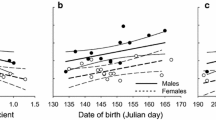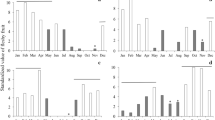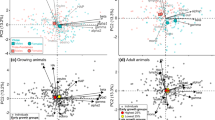Abstract
The high energetic costs of lactation can lead to fundamental trade-offs in life-history traits, particularly in young females that reproduce before completing body growth. We assessed whether lactating female mountain goats (Oreamnos americanus) used behavioural tactics at fine spatio-temporal scales to increase energy intake to compensate for the costs of lactation. Lactating females increased bite rate and chewing rate compared with non-lactating females, but selected similar foraging sites in terms of plant quality and abundance. At peak lactation, forage intake of lactating females was >40% greater than that of non-lactating females. For females that had reached asymptotic body mass (i.e. ≥6 years old), summer mass gain of lactating females was similar to that of non-lactating females. At 4 and 5 years of age, however, daily mass gain of lactating females was about 20% lower than that of non-lactating females. We conclude that increased foraging may allow fully-grown lactating females to compensate for the energetic costs of lactation, but that there is a major trade-off between mass gain and lactation for younger females.



Similar content being viewed by others
References
Altmann J (1974) Observational study of behavior: sampling methods. Behaviour 49:227–267
Arnold GW (1985) Regulation of forage intake. In: Hudson RJ, White RG (eds) Bioenergetics of wild herbivores. CRC Press, Boca Raton, pp 81–101
Arnold GW, Dudzinski ML (1967) Studies on the diet of the grazing animal. II. The effect of physiological status in ewes and pasture availability on herbage intake. Aust J Agric Res 18:349–359
Association of Official Analytical Chemists (1984) Official methods of analysis. Association of Official Analytical Chemists, Washington, DC
Baker DL, Hobbs NT (1987) Strategies of digestion: digestive efficiency and retention time of forage diets in montane ungulates. Can J Zool 65:1978–1984
Belsley DA, Kuh E, Welsch RE (2005) Regression diagnostics: identifying influential data and sources of collinearity. Wiley, New York
Blanchard P (2005) On lactation and rumination in bighorn ewes (Ovis canadensis). J Zool 265:107–112
Bonham CD (1989) Measurements for terrestrial vegetation. Wiley, New York
Bunnell FL, Gillingham MP (1985) Foraging behavior: dynamics of dining out. In: Hudson RJ, White RG (eds) Bioenergetics of wild herbivores. CRC Press, Boca Raton, pp 53–79
Burnham KP, Anderson DR (2002) Model selection and multimodel inference: a practical information-theoretic approach. Springer, New York
Clutton-Brock TH, Iason GR, Albon SD, Guinness FE (1982) Effects of lactation on feeding behaviour and habitat use in wild red deer hinds. J Zool 198:227–236
Clutton-Brock TH, Guinness FE, Albon SD (1983) The costs of reproduction to red deer hinds. J Anim Ecol 52:367–383
Côté SD (1998) In vitro digestibilities of summer forages utilized by the Riviere George caribou herd. Arctic 51:48–54
Côté SD (2000) Dominance hierarchies in female mountain goats: stability, aggressiveness and determinants of rank. Behaviour 137:1541–1566
Côté SD, Festa-Bianchet M (2001a) Reproductive success in female mountain goats: the influence of age and social rank. Anim Behav 62:173–181
Côté SD, Festa-Bianchet M (2001b) Birthdate, mass and survival in mountain goat kids: effects of maternal characteristics and forage quality. Oecologia 127:230–238
Côté SD, Festa-Bianchet M (2003) Mountain goat. In: Feldhamer GA, Thompson B, Chapman J (eds) Wild mammals of North America: biology, management and conservation. The John Hopkins University Press, Baltimore, pp 1061–1075
Côté SD, Festa-Bianchet M, Fournier F (1998a) Life-history effects of chemical immobilization and radiocollars on mountain goats. J Wildl Manag 62:745–752
Côté SD, Festa-Bianchet M, Smith KG (1998b) Horn growth in mountain goats (Oreamnos americanus). J Mammal 79:406–414
de Vries H (1995) An improved test of linearity in dominance hierarchies containing unknown or tied relationships. Anim Behav 50:1375–1389
de Vries H (1998) Finding a dominance order most consistent with a linear hierarchy: a new procedure and review. Anim Behav 55:827–843
Domingue BMF, Dellow DW, Barry NT (1991) The efficiency of chewing during eating and ruminating in goats and sheep. Br J Nutr 65:355–363
Dufour DL, Reina JC, Spurr GB (2002) Energy intake and expenditure of free-living, lactating Colombian women in an urban setting. Eur J Clin Nutr 56:205–213
Festa-Bianchet M, Côté SD (2008) Mountain goats: ecology, behavior and conservation of an alpine ungulate. Island Press, Washington, DC
Festa-Bianchet M, Jorgenson JT, Lucherini M, Wishart WD (1995) Life history consequences of variation in age of primiparity in bighorn ewes. Ecology 76:871–881
Festa-Bianchet M, Jorgenson JT, King WJ, Smith KG, Wishart WD (1996) The development of sexual dimorphism: seasonal and lifetime mass changes in bighorn sheep. Can J Zool 74:330–342
Festa-Bianchet M, Gaillard J-M, Jorgenson JT (1998) Mass- and density-dependent reproductive success and reproductive costs in a capital breeder. Am Nat 152:367–379
Fournier F, Festa-Bianchet M (1995) Social dominance in adult female mountain goats. Anim Behav 49:1449–1459
Freund R, Littell R (1992) SAS system for regression. SAS Institute, Cary
Gaillard J-M, Festa-Bianchet M, Yoccoz NG, Loison A, Toïgo C (2000) Temporal variation in fitness components and population dynamics of large herbivores. Annu Rev Ecol Syst 31:367–393
Ginnett TF, Demment MW (1997) Sex differences in giraffe foraging behavior at two spatial scales. Oecologia 110:291–300
Gittleman JL, Thompson SD (1988) Energy allocation in mammalian reproduction. Am Zool 28:863–875
Green WCH, Rothstein A (1991) Trade-offs between growth and reproduction in female bison. Oecologia 86:521–527
Gross JE, Hobbs NT, Wunder BA (1993) Independent variables for predicting intake rate of mammalian herbivores: biomass density, plant density, or bite size? Oikos 68:75–81
Gross JE, Demment MW, Alkon PU, Kotzman M (1995) Feeding and chewing behaviours of Nubian ibex: compensation for sex-related differences in body size. Funct Ecol 9:385–393
Gross JE, Alkon PU, Demment MW (1996) Nutritional ecology of dimorphic herbivores: digestion and passage rates in Nubian ibex. Oecologia 107:170–178
Hamel S (2008) Les compromis à court et à long terme associés à la reproduction chez les ongulés femelles: l’exemple de la chèvre de montagne. PhD thesis. Université Laval, Quebec City
Hamel S, Côté SD (2007) Habitat use patterns in relation to escape terrain: are alpine ungulate females trading-off better foraging sites for safety? Can J Zool 85:933–943
Hamel S, Côté SD (2008) Trade-offs in activity budget in an alpine ungulate: contrasting lactating and non-lactating females. Anim Behav 75:217–227
Hamel S, Côté SD, Gaillard J-M, Festa-Bianchet M (2009) Individual variation in reproductive costs of reproduction: high-quality females always do better. J Anim Ecol 78:143–151
Haviernick M, Côté SD, Festa-Bianchet M (1998) Immobilization of mountain goats with xylazine and reversal with idazoxan. J Wildl Dis 34:342–347
Hudson RJ, Frank S (1987) Foraging ecology of bison in aspen boreal habitats. J Range Manag 40:71–75
Iason GR, Sim DA, Gordon IJ (2000) Do endogenous seasonal cycles of food intake influence foraging behaviour and intake by grazing sheep? Funct Ecol 14:614–622
Komers PE, Messier F, Gates CC (1993) Group structure in wood bison: nutritional and reproductive determinants. Can J Zool 71:1367–1371
Krockenberger A (2003) Meeting the energy demands of reproduction in female koalas, Phascolarctos cinereus: evidence for energetic compensation. J Comp Physiol B 173:531–540
Künkele J, Trillmich F (1997) Are precocial young cheaper? Lactation energetics in the Guinea pig. Physiol Zool 70:589–596
Landete-Castillejos T, Garcia A, Garde J, Gallego L (2000) Milk intake and production curves and allosuckling in captive Iberian red deer, Cervus elaphus hispanicus. Anim Behav 60:679–687
Laurenson MK (1995) Behavioural costs and constraints of lactation in free-living cheetahs. Anim Behav 50:815–826
Littell RC, Milliken GA, Stroup WW, Wolfinger RD, Schabenberger O (2006) SAS for mixed models. SAS Institute, Cary
Machlis L, Dodd PW, Fentress JC (1985) The pooling fallacy: problems arising when individuals contribute more than one observation to the data set. Z Tierpsychol 68:201–214
MacWhirter RB (1991) Effects of reproduction on activity and foraging behaviour of adult female Columbian ground squirrels. Can J Zool 69:2209–2216
Mellish JE, Iverson SJ, Bowen WD (2000) Metabolic compensation during high energy output in fasting, lactating grey seals (Halichoerus grypus): metabolic ceilings revisited. Proc R Soc Lond Ser B 267:1245–1251
Miller KE, Bales KL, Ramos JH, Dietz JM (2006) Energy intake, energy expenditure, and reproductive costs of female wild golden lion tamarins. Am J Primatol 68:1037–1053
Moyes K, Coulson T, Morgan BJT, Donald A, Morris SJ, Clutton-Brock TH (2006) Cumulative reproduction and survival costs in female red deer. Oikos 115:241–252
Murray MG (1991) Maximizing energy retention in grazing ruminants. J Anim Ecol 60:1029–1045
Neuhaus P, Ruckstuhl KE (2002a) The link between sexual dimorphism, activity budgets, and group cohesion: the case of the plains zebra (Equus burchelli). Can J Zool 80:1437–1441
Neuhaus P, Ruckstuhl KE (2002b) Foraging behaviour in Alpine ibex (Capra ibex): consequences of reproductive status, body size, age and sex. Ethol Ecol Evol 14:373–381
Noldus Information Technology (1998) Matman, reference manual. Noldus Information Technology, Wageningen
Oftedal OT (1985) Pregnancy and lactation. In: Hudson RJ, White RG (eds) Bioenergetics of wild herbivores. CRC Press, Boca Raton, pp 215–236
Pan J, Koike S, Suzuki T, Ueda K, Kobayashi Y, Tanaka K, Okubo M (2003) Effect of mastication on degradation of orchardgrass hay stem by rumen microbes: fibrolytic enzyme activities and microbial attachment. Anim Feed Sci Technol 106:69–79
Parker KL, Barboza PS, Gillingham MP (2009) Nutrition integrates environmental responses of ungulates. Funct Ecol 23:57–69
Pérez-Barbería FJ, Gordon IJ (1998) Factors affecting food comminution during chewing in ruminants: a review. Biol J Linn Soc 63:233–256
Racey PA, Speakman JR (1987) The energy costs of pregnancy and lactation in heterothermic bats. Symp Zool Soc Lond 57:107–125
Renecker LA, Hudson RJ (1986) Seasonal foraging rates of free-ranging moose. J Wildl Manag 50:143–147
Ruckstuhl KE, Festa-Bianchet M (1998) Do reproductive status and lamb gender affect the foraging behavior of bighorn ewes? Ethology 104:941–954
Ruckstuhl KE, Festa-Bianchet M, Jorgenson JT (2003) Bite rates in Rocky Mountain bighorn sheep (Ovis canadensis): effects of season, age, sex and reproductive status. Behav Ecol Sociobiol 54:167–173
Sadleir RMFS (1982) Energy consumption and subsequent partitioning in lactating black-tailed deer. Can J Zool 60:382–386
Sæther B-E, Haagenrud H (1985) Life history of the moose Alces alces: relationship between growth and reproduction. Holarct Ecol 8:100–106
Shipley LA, Gross JE, Spalinger DE, Hobbs NT, Wunder BA (1994) The scaling of intake rate in mammalian herbivores. Am Nat 143:1055–1082
Shipley LA, Illius AW, Danell K, Hobbs NT, Spalinger DE (1999) Predicting bite size selection of mammalian herbivores: a test of a general model of diet optimization. Oikos 84:55–68
Sokal RR, Rohlf FJ (1981) Biometry: the principles and practice of statistics in biological research. W. H. Freeman, San Francisco
Spalinger DE, Hobbs NT (1992) Mechanisms of foraging in mammalian herbivores: new models of functional response. Am Nat 140:325–348
Stearns SC (1992) The evolution of life histories. Oxford University Press, Oxford
Stevens V, Houston DB (1989) Reliability of age determination of mountain goats. Wildl Soc Bull 17:72–74
Tavecchia G, Coulson T, Morgan BJT, Pemberton JM, Pilkington JC, Gulland FMD, Clutton-Brock TH (2005) Predictors of reproductive cost in female Soay sheep. J Anim Ecol 74:201–213
van Hoven W, Boomker EA (1985) Digestion. In: Hudson RJ, White RG (eds) Bioenergetics of wild herbivores. CRC Press, Boca Raton, pp 103–120
Van Soest PJ (1994) Nutritional ecology of the ruminant. Cornell University Press, New York
Veiberg V, Mysterud A, Bjørkvoll E, Langvatn R, Loe LE, Irvine RJ, Bonenfant C, Couweleers F, Stenseth NC (2007) Evidence for a trade-off between early growth and tooth wear in Svalbard reindeer. J Anim Ecol 76:1139–1148
Wickstrom ML, Robbins CT, Hanley TA, Spalinger DE, Parish SM (1984) Food intake and foraging energetics of elk and mule deer. J Wildl Manag 48:1285–1301
Xu R (2003) Measuring explained variation in linear mixed effects models. Stat Med 22:3527–3541
Acknowledgments
Our research was financed by the Alberta Conservation Association, the Alberta Fish and Wildlife Division, the Alberta Sport, Recreation, Parks and Wildlife Foundation, the Natural Sciences and Engineering Research Council of Canada (NSERC), and Université Laval. S.H. received scholarships from NSERC and the Fonds Québécois de la Recherche sur la Nature et les Technologies. We especially thank M. Festa-Bianchet and K.G. Smith for fruitful discussions and logistical help. We are grateful to M. Bégin Pépin, C. Cameron, E. Cardinal, G. Côté, E. Drouin, M. Favre, C.A. Gagnon, Y. Gendreau, M. Houle, L. MacPherson, S. Popp, S. Rioux and V. Viera for help with field work, and to A. Brousseau, M. Gravel, L. L’Italien, and G. Picard for help with laboratory work. We thank the Centre de Conservation de la Biodiversité Boréale for allowing us to work with captive mountain goats, and C. Gagnon and R. Hamel for logistical help in this experiment. Valuable comments from P. Blanchard, J.-M. Gaillard, V. Harvey, I. Kojola, J. Taillon and two anonymous reviewers improved earlier versions of this manuscript. This research project was approved by the Canadian Council for Animal Care committee of the Université Laval.
Author information
Authors and Affiliations
Corresponding author
Additional information
Communicated by Jean-Michel Gaillard.
Electronic supplementary material
Below is the link to the electronic supplementary material.
Rights and permissions
About this article
Cite this article
Hamel, S., Côté, S.D. Foraging decisions in a capital breeder: trade-offs between mass gain and lactation. Oecologia 161, 421–432 (2009). https://doi.org/10.1007/s00442-009-1377-y
Received:
Accepted:
Published:
Issue Date:
DOI: https://doi.org/10.1007/s00442-009-1377-y




